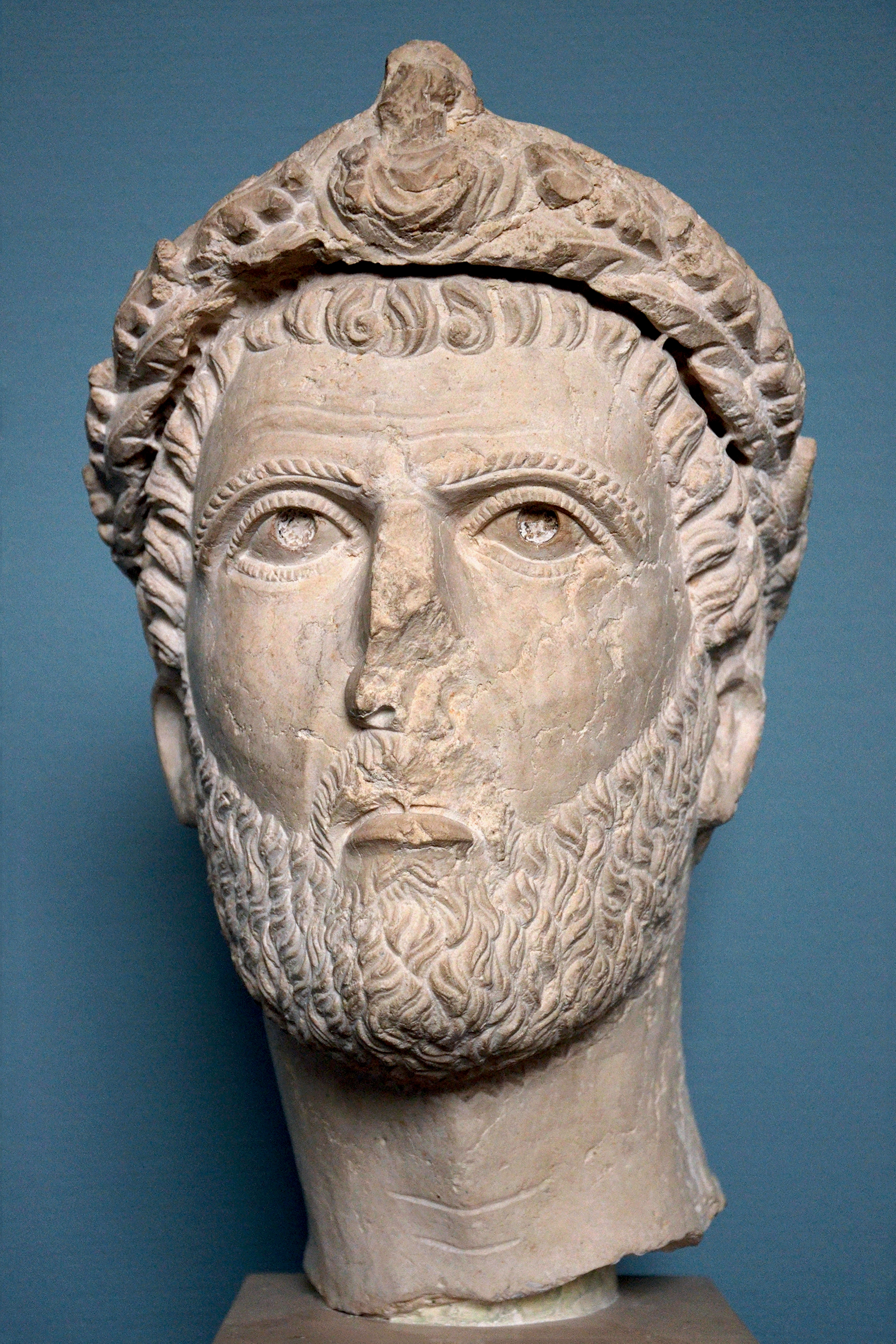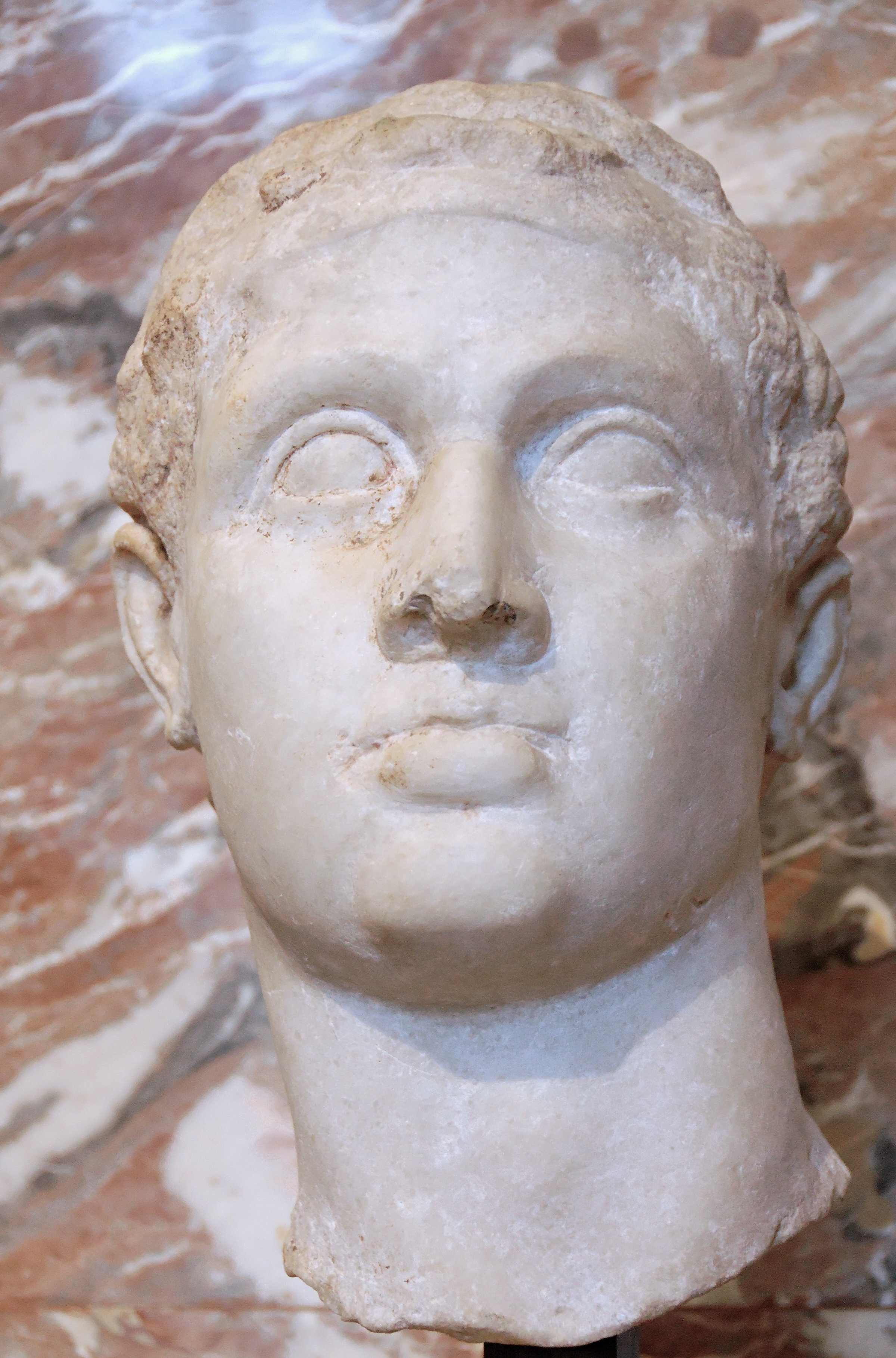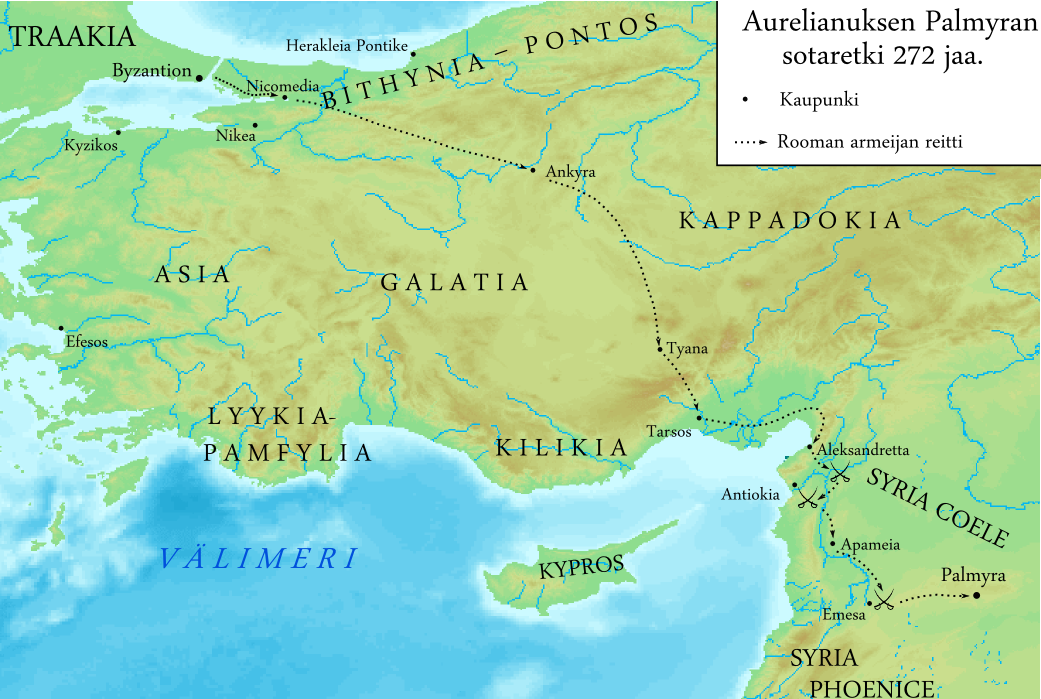|
Timolaus Of Palmyra
Timolaus of Palmyra (Latin: Timolaus) was reportedly a 3rd century Palmyrene nobleman, son of the king of kings Odaenathus (r. 252-267) and augustus Zenobia (r. 267-272). Little is known about him, and all the existing information comes from speculation. Such is the doubt of his existence that some scholars try to associate him with Vaballathus (r. 267-272), another of the sons of Odaenathus and Zenobia. Some authors believe he is an individual made up by the ''Historia Augusta'', the only historical source that cites him, and some speculate that he is in fact a historical figure. He appears only in 267, at the time of his father's assassination. Family Timolaus was the son of Odaenathus and his second wife Zenobia, grandson of Hairan I, great-grandson of Vaballathus, and great-great-grandson of Nasor. He was the half-brother of Hairan I, the fruit of Odaenathus' relationship with a previous wife. He also had two sisters, whose names are not known. It is known, however, that t ... [...More Info...] [...Related Items...] OR: [Wikipedia] [Google] [Baidu] |
Brackets
A bracket is either of two tall fore- or back-facing punctuation marks commonly used to isolate a segment of text or data from its surroundings. Typically deployed in symmetric pairs, an individual bracket may be identified as a 'left' or 'right' bracket or, alternatively, an "opening bracket" or "closing bracket", respectively, depending on the Writing system#Directionality, directionality of the context. Specific forms of the mark include parentheses (also called "rounded brackets"), square brackets, curly brackets (also called 'braces'), and angle brackets (also called 'chevrons'), as well as various less common pairs of symbols. As well as signifying the overall class of punctuation, the word "bracket" is commonly used to refer to a specific form of bracket, which varies from region to region. In most English-speaking countries, an unqualified word "bracket" refers to the parenthesis (round bracket); in the United States, the square bracket. Glossary of mathematical sym ... [...More Info...] [...Related Items...] OR: [Wikipedia] [Google] [Baidu] |
Roman Senate
The Roman Senate ( la, Senātus Rōmānus) was a governing and advisory assembly in ancient Rome. It was one of the most enduring institutions in Roman history, being established in the first days of the city of Rome (traditionally founded in 753 BC). It survived the overthrow of the Roman monarchy in 509 BC; the fall of the Roman Republic in the 1st century BC; the division of the Roman Empire in AD 395; and the fall of the Western Roman Empire in 476; Justinian's attempted reconquest of the west in the 6th century, and lasted well into the Eastern Roman Empire's history. During the days of the Roman Kingdom, most of the time the Senate was little more than an advisory council to the king, but it also elected new Roman kings. The last king of Rome, Lucius Tarquinius Superbus, was overthrown following a coup d'état led by Lucius Junius Brutus, who founded the Roman Republic. During the early Republic, the Senate was politically weak, while the various executive magistr ... [...More Info...] [...Related Items...] OR: [Wikipedia] [Google] [Baidu] |
Rome
, established_title = Founded , established_date = 753 BC , founder = King Romulus (legendary) , image_map = Map of comune of Rome (metropolitan city of Capital Rome, region Lazio, Italy).svg , map_caption = The territory of the ''comune'' (''Roma Capitale'', in red) inside the Metropolitan City of Rome (''Città Metropolitana di Roma'', in yellow). The white spot in the centre is Vatican City. , pushpin_map = Italy#Europe , pushpin_map_caption = Location within Italy##Location within Europe , pushpin_relief = yes , coordinates = , coor_pinpoint = , subdivision_type = Country , subdivision_name = Italy , subdivision_type2 = Region , subdivision_name2 = Lazio , subdivision_type3 = Metropolitan city , subdivision_name3 = Rome Capital , government_footnotes= , government_type = Strong Mayor–Council , leader_title2 = Legislature , leader_name2 = Capitoline Assemb ... [...More Info...] [...Related Items...] OR: [Wikipedia] [Google] [Baidu] |
Palmyrene Empire
The Palmyrene Empire was a short-lived breakaway state from the Roman Empire resulting from the Crisis of the Third Century. Named after its capital city, Palmyra, it encompassed the Roman provinces of Syria Palaestina, Arabia Petraea, and Egypt, as well as large parts of Asia Minor. The Palmyrene Empire was ruled by Queen Zenobia, officially as regent for her son Vaballathus, who inherited the throne in 267 at age ten. In 270, Zenobia rapidly conquered most of the Roman east, attempting to maintain relations with Rome as a legitimate power. In 271, she claimed the imperial title for both herself and her son, fighting a short war with the Roman emperor Aurelian, who conquered Palmyra and captured Zenobia. A year later the Palmyrenes rebelled, which led Aurelian to destroy Palmyra. Despite its brief existence, the Palmyrene Empire is remembered for having been ruled by one of the most ambitious and powerful women in antiquity. It is also hailed in Syria, where it plays an import ... [...More Info...] [...Related Items...] OR: [Wikipedia] [Google] [Baidu] |
Cleopatra
Cleopatra VII Philopator ( grc-gre, Κλεοπάτρα Φιλοπάτωρ}, "Cleopatra the father-beloved"; 69 BC10 August 30 BC) was Queen of the Ptolemaic Kingdom of Egypt from 51 to 30 BC, and its last active ruler.She was also a diplomat, naval commander, linguist, and medical author; see and . A member of the Ptolemaic dynasty, she was a descendant of its founder Ptolemy I Soter, a Macedonian Greek general and companion of Alexander the Great. writes about Ptolemy I Soter: "The Ptolemaic dynasty, of which Cleopatra was the last representative, was founded at the end of the fourth century BC. The Ptolemies were not of Egyptian extraction, but stemmed from Ptolemy Soter, a Macedonian Greek in the entourage of Alexander the Great."For additional sources that describe the Ptolemaic dynasty as " Macedonian Greek", please see , , , and . Alternatively, describes them as a "Macedonian, Greek-speaking" dynasty. Other sources such as and describe the Ptolemies a ... [...More Info...] [...Related Items...] OR: [Wikipedia] [Google] [Baidu] |
Semiramis
''Samīrāmīs'', hy, Շամիրամ ''Šamiram'') was the semi-legendary Lydian- Babylonian wife of Onnes and Ninus, who succeeded the latter to the throne of Assyria, according to Movses Khorenatsi. Legends narrated by Diodorus Siculus, who drew primarily from the works of Ctesias of Cnidus,Diodorus Siculus: The Library of History, Book II, Chapters 1-22 describe her and her relationships to Onnes and King Ninus. Armenians and the Assyrians of Iraq, northeast Syria, southeast Turkey, and northwest Iran still use ''Shamiram'' as a given name for girls. The real and historical Shammuramat (the original Akkadian form of the name) was the Assyrian wife of Shamshi-Adad V (ruled 824 BC–811 BC). She was the ruler of the Neo-Assyrian Empire as its regent for five years before her son Adad-nirari III came of age and took the reins of power. She ruled at a time of political uncertainty, which is one of the possible explanations for why Assyrians may have accepted the rule of a woman w ... [...More Info...] [...Related Items...] OR: [Wikipedia] [Google] [Baidu] |
Dido
Dido ( ; , ), also known as Elissa ( , ), was the legendary founder and first queen of the Phoenician city-state of Carthage (located in modern Tunisia), in 814 BC. In most accounts, she was the queen of the Phoenician city-state of Tyre (today in Lebanon) who fled tyranny to found her own city in northwest Africa. Known only through ancient Greek and Roman sources, all of which were written well after Carthage's founding, her historicity remains uncertain. The oldest references to Dido are attributed to Timaeus, who was active around 300 BC, or about five centuries after the date given for the foundation of Carthage. Details about Dido's character, life, and role in the founding of Carthage are best known from the account given in Virgil's epic poem, the ''Aeneid,'' written around 20 BC, which tells the legendary story of the Trojan hero Aeneas. Dido is described as a clever and enterprising woman who flees her ruthless and autocratic brother, Pygmalion, after discovering ... [...More Info...] [...Related Items...] OR: [Wikipedia] [Google] [Baidu] |
Maeonius
Maeonius (died c. 267), or Maconius, was a short-lived ruler of Palmyra. Life He was the nephew (according to Zonaras xii.24) or the cousin (according to ''Historia Augusta'', which lists him among the Thirty Tyrants) of Odaenathus of Palmyra, who had taken control of the eastern provinces of the Roman Empire after the defeat in battle and capture of Emperor Valerian by Shapur I of the Sassanid Empire. According to ''Historia Augusta'', Maeonius killed Odaenathus and his son Hairan during a celebration, because of a conspiracy organised by Zenobia, wife of Odaenathus, who wanted her sons to succeed her husband instead of Hairan (who was the son of Odaenathus by another woman). According to Gibbon, the murder was revenge for a short confinement imposed on Maeonius by Odaenathus for being disrespectful. Zonaras tells that Maeonius was killed immediately after the murder of Odaenathus, while ''Historia'' has Maeonius proclaiming himself emperor, with Zenobia having him soon kill ... [...More Info...] [...Related Items...] OR: [Wikipedia] [Google] [Baidu] |
Aramaic
The Aramaic languages, short Aramaic ( syc, ܐܪܡܝܐ, Arāmāyā; oar, 𐤀𐤓𐤌𐤉𐤀; arc, 𐡀𐡓𐡌𐡉𐡀; tmr, אֲרָמִית), are a language family containing many varieties (languages and dialects) that originated in the ancient region of Syria. For over three thousand years, It is a sub-group of the Semitic languages. Aramaic varieties served as a language of public life and administration of ancient kingdoms and empires and also as a language of divine worship and religious study. Several modern varieties, namely the Neo-Aramaic languages, are still spoken in the present-day. The Aramaic languages belong to the Northwest group of the Semitic language family, which also includes the Canaanite languages such as Hebrew, Edomite, Moabite, and Phoenician, as well as Amorite and Ugaritic. Aramaic languages are written in the Aramaic alphabet, a descendant of the Phoenician alphabet, and the most prominent alphabet variant is the Syriac alphabet. The ... [...More Info...] [...Related Items...] OR: [Wikipedia] [Google] [Baidu] |
Septimius Antiochus
Septimius Antiochus (died after 273) was a Roman usurper in Syria during the 3rd century. In 272 AD Emperor Aurelian had defeated the breakaway Kingdom of Palmyra; its king Vaballathus and his mother Zenobia were in Roman captivity. In 273 AD another rebellion against Roman rule broke out in Palmyra. The rebels first approached Aurelian's governor Marcellinus to become emperor, but he pretended to consider the offer as he sent a letter to Aurelian warning of the rebellion. While the rebels were waiting they decided to elevate Septimius Antiochus, the reputed son of Zenobia, to the purple. Receiving Marcellinus's letter, the Emperor reacted quickly, and in the spring of 273 the city was brought back under Roman rule. Aurelian punished the city heavily, but allegedly spared Antiochus. Antiochus claimed to be descended from Queen Cleopatra VII Cleopatra VII Philopator ( grc-gre, Κλεοπάτρα Φιλοπάτωρ}, "Cleopatra the father-beloved"; 69 BC10 August 30&nbs ... [...More Info...] [...Related Items...] OR: [Wikipedia] [Google] [Baidu] |
Hairan II
Hairan II was a Palmyrene prince, the son of king Odaenathus and, possibly, his second wife Zenobia. Seal RTP 736 The existence of Hairan was established by the discovery of a lead seal (code named RTP 736). The seal bears the images of two priests, one on each side. On one of the sides, the name of Odaenathus' son and successor Vaballathus was engraved under the image as a legend, while the name of Hairan was engraved on the other side. The name of Odaenathus was engraved on both sides. No name of a mother was engraved and the seal is undated. King Herodianus and Hairan II Odaenathus had another son, Hairan I, who appeared in different inscriptions dated from 251 AD onward. On a lead seal, the name of Septimius Herodianus, king of kings, appears; scholars argue whether Septimius Herodianus was Hairan I or II. The ''Augustan History'' mentions that Odaenathus had many sons, including one named Herodes (from an earlier marriage) and another named Herennianus. According to Henri ... [...More Info...] [...Related Items...] OR: [Wikipedia] [Google] [Baidu] |
Aurelian
Aurelian ( la, Lucius Domitius Aurelianus; 9 September 214 October 275) was a Roman emperor, who reigned during the Crisis of the Third Century, from 270 to 275. As emperor, he won an unprecedented series of military victories which reunited the Roman Empire after it had nearly disintegrated under the pressure of barbarian invasions and internal revolts. Born in humble circumstances, near the Danube River, he entered the Roman military in 235, and climbed up the ranks. He went on to lead the cavalry of the emperor Gallienus, until Gallienus' assassination in 268. Following that, Claudius Gothicus became emperor until his own death in 270. Claudius' brother Quintillus ruled the empire for three months, before Aurelian became emperor. During his reign, he defeated the Alamanni after a devastating war. He also defeated the Goths, Vandals, Juthungi, Sarmatians, and Carpi. Aurelian restored the Empire's eastern provinces after his conquest of the Palmyrene Empire in 273. The follow ... [...More Info...] [...Related Items...] OR: [Wikipedia] [Google] [Baidu] |







